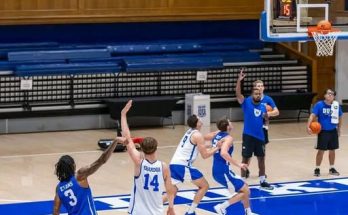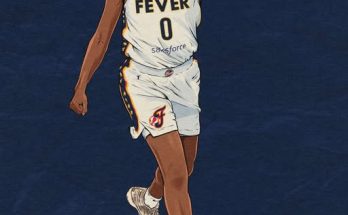The echoes of Alabama football history—roars of national championships, clinks of celebratory glasses, the chatter of lifelong fans—have long reverberated through the walls of a beloved local institution. But in a matter of minutes, that storied past suffered a devastating blow. A powerful storm swept through the region last week, leaving destruction in its wake and, in the process, tearing down one of the most iconic symbols of Alabama pride: the famed Championship Wall at Tuscaloosa’s beloved “The Houndstooth Grille & Tavern.”
For decades, the wall stood as a tribute to Crimson Tide greatness, a hand-crafted collage of framed photos, autographed memorabilia, newspaper clippings, and personal notes from some of Alabama’s most legendary players and coaches. Tourists and locals alike would flock to the establishment, not just for the Southern comfort food and cold beer, but to stand in awe before a literal shrine to Alabama football dominance. The wall told stories that weren’t in the box scores—of grit, of glory, of Bear Bryant’s ghost, and of Nick Saban’s reign. It was more than décor; it was heritage.
When the storm hit Tuscaloosa in the early morning hours, winds reportedly reached over 80 mph. What began as a weather advisory turned into a full-blown emergency for several businesses and homes in the downtown area. At The Houndstooth, the damage was sudden and brutal. Part of the roof over the main dining hall gave way under the weight of a falling tree, allowing rain and debris to pour into the structure. The famed Championship Wall was in the path of destruction, and within moments, it was gone—water-soaked, collapsed, and shattered beyond recognition.
Owner Riley McCall, whose family has run The Houndstooth for three generations, said he was devastated when he arrived to assess the damage. “I just stood there in disbelief,” he said. “This wasn’t just a wall. This was my childhood. This was my grandfather’s love for Alabama football. This was everything we believed in.” With tears in his eyes, McCall described how his grandfather, a die-hard Crimson Tide fan, began assembling the collection in the late 1970s. “He used to say, ‘If those boys can fight through fourth and long, we can make it through anything.’ That wall reminded us of that every day.”
The community response was immediate and emotional. Longtime patrons took to social media to express their heartbreak. Former players, now scattered across the country, shared memories of the times they visited the restaurant, pointing out their own photos and marveling at the breadth of history contained in that modest corner of the tavern. Some posted old snapshots they had taken in front of the wall, now valuable pieces of nostalgia.
One of those voices was former Alabama linebacker Dont’a Hightower, who played a pivotal role in the Tide’s 2009 and 2011 national championships. “That wall was part of the fabric of Tuscaloosa,” Hightower wrote on Instagram. “I remember pointing out my jersey from the BCS game to my son when we visited last year. It’s a damn shame. Praying for The Houndstooth and everyone affected.”
But even as the debris was being cleared, something remarkable began to happen—what started as mourning shifted into movement. Fans began dropping by the restaurant not just to offer condolences, but to donate memorabilia. A signed football here, a framed ticket stub there, and dozens of pictures from games spanning the last half-century began arriving, each accompanied by a story. One elderly couple brought in a tattered program from the 1965 Orange Bowl, smiling through tears as they recalled watching the game together on their honeymoon.
“It’s almost like we’re rebuilding more than a wall,” said McCall. “We’re rebuilding our story. A lot of what was lost can’t be replaced, but we can still honor it. We can still pass it on.”
The restoration process is now underway, with volunteers and professionals working side-by-side to stabilize the restaurant’s structure and assess the viability of recreating the Championship Wall. An online fundraiser launched just 48 hours after the storm has already amassed over $90,000 from fans all over the country. “People are giving from everywhere—Georgia, Florida, even California. That’s what Alabama football does—it connects people,” said McCall.
In a poignant move, University of Alabama Athletic Director Greg Byrne paid a visit to the site, accompanied by several players and staff. “This place matters,” Byrne said. “It’s more than just burgers and beers. It’s where people come to celebrate victories, mourn losses, and feel connected to something bigger than themselves.” The university is reportedly working with The Houndstooth to recover or replace some of the more valuable items that were destroyed, including signed jerseys from championship rosters and rare press clippings.
There is also talk of a new tradition forming in the wake of the tragedy. Rather than restoring the wall exactly as it was, McCall says the new version may include digital elements—interactive screens that let fans contribute their own memories, rotating images of iconic plays, even audio clips of legendary calls. “Maybe it’s time we embrace the next chapter,” he said. “The old wall told the story up to now. The new one can tell the story of how we came together to keep it alive.”
While the physical loss is still raw, the spirit of The Houndstooth remains unbroken. Regulars continue to show up, even as crews hammer and saw in the background. Locals order takeout in bulk, hoping to keep revenue flowing during the rebuilding phase. A group of university students even organized a clean-up drive, wearing crimson t-shirts that read “For the Wall. For the Tide.”
There’s a lesson in all of this, McCall believes. “Buildings can be rebuilt. Memories can be shared again. But what matters most—our passion, our community, our pride in Alabama football—that never left. If anything, it’s stronger now.”
Indeed, the storm may have torn down a wall, but it also revealed what that wall stood for—unity, resilience, and an unwavering love for Crimson Tide football. In the end, The Houndstooth isn’t defined by plaster and pictures. It’s defined by people who refuse to let history be forgotten, who carry its legacy forward one memory at a time.
And when the new wall is finally unveiled, it won’t just represent a return to what was. It will stand as a testament to what can be rebuilt, together.



